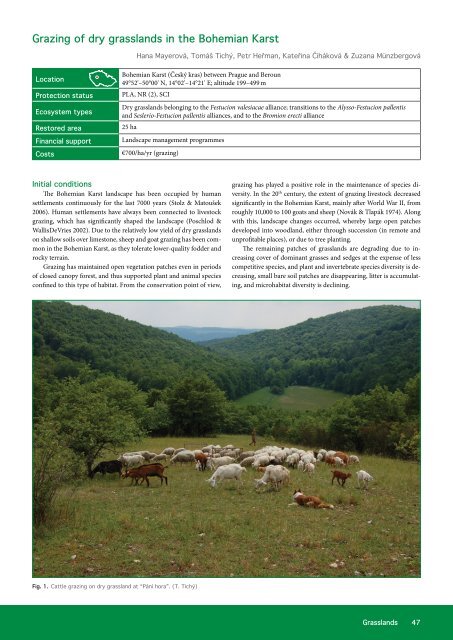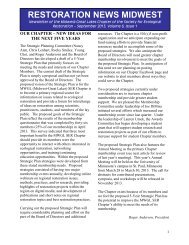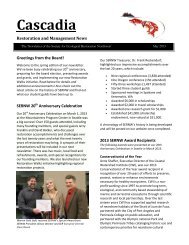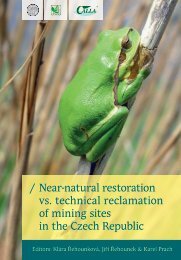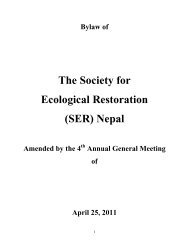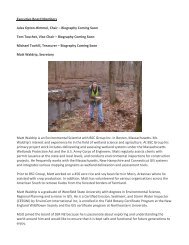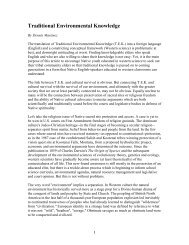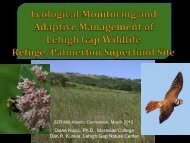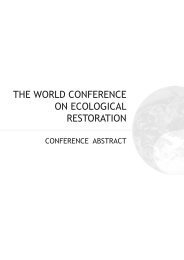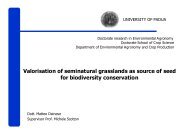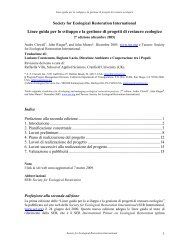Ecological restoration in the Czech Republic
Ecological restoration in the Czech Republic - Society for Ecological ...
Ecological restoration in the Czech Republic - Society for Ecological ...
- No tags were found...
You also want an ePaper? Increase the reach of your titles
YUMPU automatically turns print PDFs into web optimized ePapers that Google loves.
Graz<strong>in</strong>g of dry grasslands <strong>in</strong> <strong>the</strong> Bohemian Karst<br />
<br />
Location<br />
Protection status<br />
Ecosystem types<br />
Restored area<br />
F<strong>in</strong>ancial support<br />
Costs<br />
Bohemian Karst (Český kras) between Prague and Beroun<br />
49°52'–50°00' N, 14°02'–14°21' E; altitude 199–499 m<br />
PLA, NR (2), SCI<br />
Dry grasslands belong<strong>in</strong>g to <strong>the</strong> Festucion valesiacae alliance; transitions to <strong>the</strong> Alysso-Festucion pallentis<br />
and Seslerio-Festucion pallentis alliances, and to <strong>the</strong> Bromion erecti alliance<br />
25 ha<br />
Landscape management programmes<br />
€700/ha/yr (graz<strong>in</strong>g)<br />
Initial conditions<br />
The Bohemian Karst landscape has been occupied by human<br />
settlements cont<strong>in</strong>uously for <strong>the</strong> last 7000 years (Stolz & Matoušek<br />
2006). Human settlements have always been connected to livestock<br />
graz<strong>in</strong>g, which has significantly shaped <strong>the</strong> landscape (Poschlod &<br />
WallisDeVries 2002). Due to <strong>the</strong> relatively low yield of dry grasslands<br />
on shallow soils over limestone, sheep and goat graz<strong>in</strong>g has been common<br />
<strong>in</strong> <strong>the</strong> Bohemian Karst, as <strong>the</strong>y tolerate lower-quality fodder and<br />
rocky terra<strong>in</strong>.<br />
Graz<strong>in</strong>g has ma<strong>in</strong>ta<strong>in</strong>ed open vegetation patches even <strong>in</strong> periods<br />
of closed canopy forest, and thus supported plant and animal species<br />
conf<strong>in</strong>ed to this type of habitat. From <strong>the</strong> conservation po<strong>in</strong>t of view,<br />
graz<strong>in</strong>g has played a positive role <strong>in</strong> <strong>the</strong> ma<strong>in</strong>tenance of species diversity.<br />
In <strong>the</strong> 20 th century, <strong>the</strong> extent of graz<strong>in</strong>g livestock decreased<br />
significantly <strong>in</strong> <strong>the</strong> Bohemian Karst, ma<strong>in</strong>ly after World War II, from<br />
roughly 10,000 to 100 goats and sheep (Novák & Tlapák 1974). Along<br />
with this, landscape changes occurred, whereby large open patches<br />
developed <strong>in</strong>to woodland, ei<strong>the</strong>r through succession (<strong>in</strong> remote and<br />
unprofitable places), or due to tree plant<strong>in</strong>g.<br />
The rema<strong>in</strong><strong>in</strong>g patches of grasslands are degrad<strong>in</strong>g due to <strong>in</strong>creas<strong>in</strong>g<br />
cover of dom<strong>in</strong>ant grasses and sedges at <strong>the</strong> expense of less<br />
competitive species, and plant and <strong>in</strong>vertebrate species diversity is decreas<strong>in</strong>g,<br />
small bare soil patches are disappear<strong>in</strong>g, litter is accumulat<strong>in</strong>g,<br />
and microhabitat diversity is decl<strong>in</strong><strong>in</strong>g.<br />
Fig. 1. <br />
Grasslands 47


